In the Cards, Part 2
Last week, I started talking about some of the cards in Core Set 2019. I didn't go through everything I wanted to mention, so today I'm back with more cards to talk about.
Liliana, Untouched by Death
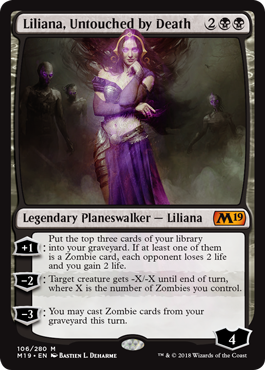
Liliana comes to Core Set 2019 through her Demonic Pact storyline. This happens after the Mending when Liliana starts aging again and makes the deal with Bolas and four demons for eternal youth and immortality. Liliana's core identity as a Planeswalker is her ability as a necromancer.
The decision with this card was to make her a Zombie tribal planeswalker, one you would build a Zombie deck around. This means that all three abilities want to reward you for having a lot of Zombies. The first ability is a creative solution to a number of problems. First, the card wants to be tied to Zombies, but you want to make sure there is more function to the card than just making Zombies. Second, the ultimate wants Zombie cards in your graveyard. Having the plus ability enable that will make the ultimate more impactful when it happens.
Self-milling allows the card to enable the ultimate while also caring about Zombie cards in a different way. In addition, this allows the card to get another effect, a 2-life drain, by having the milled Zombies trigger an effect. The second ability allows Liliana to use Zombies to do another important effect, creature destruction. The more Zombies you have, the stronger this ability becomes. The final ability is a splashy ability that ties into Zombies while allowing Liliana to do something slightly different than her other ultimates. Note that the ultimate is lower than her starting loyalty cost, meaning that this is a rare planeswalker card that allows you to use any of the three abilities as soon as it's cast.
Liliana's Contract
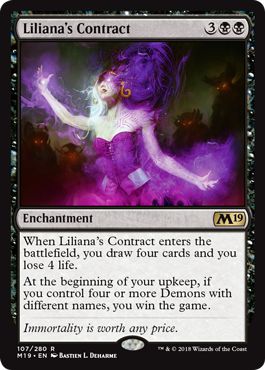
One of the debates we have in R&D is whether making Magic sets is a science or an art. I lean toward art, and this card demonstrates why. The goal when designing a Magic card is to make something players want to play and enjoy playing. Sometimes that's simply a matter of making a card functional and powerful, but not every card gets to be something you have to stick in a deck of a certain color. Other ways to solve this is to make cards that are specifically designed to shine in other formats, be they Limited, multiplayer, or various older formats.
Sometimes though, the key to making a card players like is a little less cerebral. It's finding some aspect that can shine through in a way that just makes players happy. It could be pushing toward humor. It could be an odd implementation that does something a little different than normal. Or it could be about capturing a neat meshing of mechanics and flavor. Liliana's Contract makes me smile because it takes a key story point about one of our major characters and finds a beautiful intersection of design to bring it all to life.
Black often does card drawing for life payments, and we frequently flavor them as making contracts with an unsavory source. Let's start by using this as a means to represent Liliana's demonic pact. Because it's a rare, we're able to do a large amount of card drawing, four cards in this case (the number four is no accident, by the way). Then it adds a little rider that puts it all in context. You can win the game if you can get four Demons on the battlefield, representing the four Demons (Kothophed, Griselbrand, Razaketh, and Belzenlok) with which Liliana made her pact. The whole package makes a card that just holds together as, well, a piece of art.
Metamorphic Alteration
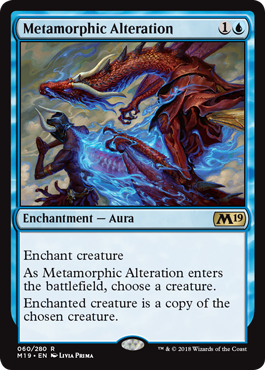
I was working on a future set, and we had a design in it that was awesome. I was so happy with it. And then one day, I'm doing a playtest of Core Set 2019 and I see the card, with a different name, in my draft. I cried out at the draft table "Noooo!" I had my hands up in the air and everything. Obviously, this made a bunch of people turn their heads toward me and ask what was wrong. My reply: "They beat me to it!"
You see, the rule in R&D is that the early set has precedence on card designs. If you make a card for the 2020 fall set, any set before the 2020 fall set can make that card first. Now obviously, if that card is key to what your set is doing, you can talk with those ahead of you, but except in specific cases, you lose the card to the earlier set. I knew our set didn't have to have the card, so it was going to appear in Core Set 2019.
Metamorphic Alteration thus will forever be the card that got away. I should note this has happened many, many times before, so it's nothing new. We just had a pretty cool flavor twist for this card, which would make sense in the future set, but not in this set. Oh, well. Enjoy this card here. It's a lot of fun. I really enjoy how it takes a concept, clones, that goes all the way back to Limited Edition (Alpha) and uses it in a straightforward way. So straightforward that when we made it, we were surprised it hadn't been done already. So close.
Nicol Bolas, the Ravager

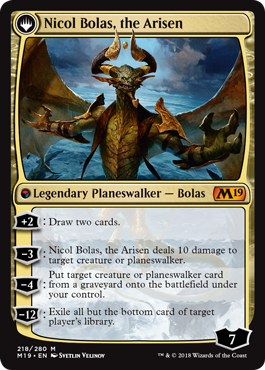
The second it was nailed down that Core Set 2019 would revolve around Bolas, Ethan Fleischer, the set's lead set designer, said he was making a double-faced Bolas card a la the Magic Origins planeswalkers, with an unsparked legendary creature on one side and a planeswalker on the other. There were some logistics to work through as we'd never made a set with just one double-faced card before, but everyone agreed it was the right call, so we figured out how to do it.
The front side needed to reflect Bolas pre-spark, so they tapped into his Legends card and gave him a discard ability. To keep the text shorter and to keep you from wanting to keep legendary Nicol Bolas on the battlefield too long, they made the discard effect an "enters-the-battlefield" effect. Rather than make him a 7/7, as he was in Legends, they opted for a smaller but cheaper 4/4 flier you could drop for four mana earlier in the game. There was a bunch of discussion about how to turn him into a planeswalker, but R&D ultimately decided to just make it an activated ability.
As this card was the focus of the set, the set design team decided to give the planeswalker side four loyalty abilities. The first and only plus ability draws you cards to play into Bolas's intelligence and thirst for knowledge. The second ability allows you to kill a creature or planeswalker and plays up his destructive nature. His third ability allows him to reanimate creatures and planeswalkers, hinting at his actions on Amonkhet. Notice that the first ability was blue, the second red and the third black.
The ultimate wanted to be something splashy as you have to go through a lot of hoops to get there. We don't like to put "win the game" on ultimates, but Bolas's ultimate gets to come pretty close. It also plays into the flavor that Bolas is known for: destroying people's minds. The ultimate was made "target player" rather than hitting all opponents, as hitting everyone was a little too brutal in multiplayer play.
Nightmare's Thirst
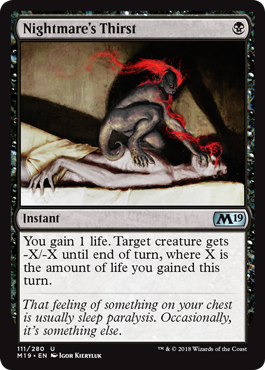
This is an interesting design. It was created to be a card you want to combo with a life gaining card to kill big creatures for very little mana. The problem is if the card only works when you have the life gain card, it becomes a card that just gets stuck in your hand most of the time. So, the designers did something cool. They built in a little utility that makes the card function by itself and allows you to chain them together to make a bigger effect. You see, by itself, it's basically gain 1 life and give -1/-1 to a creature. The second one you cast, though, gains you 1 life and gives -2/-2 to a creature because it gets to count the life gain of the first card. The reason I like this design a lot is because it's not always so easy to make a card that works by itself, with other copies of itself, and with other effects, so as a fellow designer, I'm impressed.
Resplendent Angel
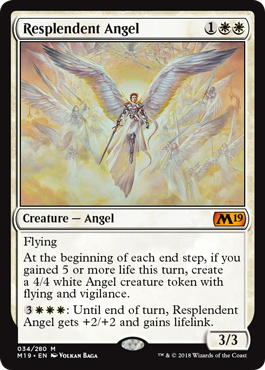
This card has an interesting design. The card is made as a build-around where you combine it with cards that gain you 5 or more life. Even though this is a mythic rare, people are going to get this in Limited and it's kind of hard to gain 5 life in Limited, so the designers added in a way where the card can combo with itself. How do you do that on a 3/3 flier? Well, you could just have it gain you 5 life, but that's a little too blunt. Part of the fun of designs like this is finding a more creative and organic way to build in a synergy. The solution on this card was to give the Angel +2/+2 and lifelink. The overall package just feels better and more like a cohesive card.
Sarkhan, Fireblood
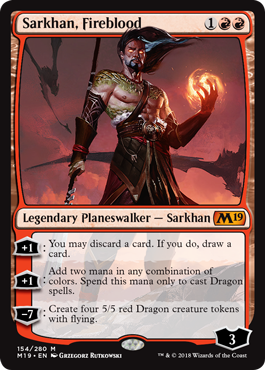
Sarkhan has one of the narrower mechanical focuses for planeswalkers: he focuses on Dragons. Sarkhan is from the Zendikar storyline when Nicol Bolas pressured Sarkhan into doing some things for him. The events of this story make Sarkhan go mad, but this card represents Sarkhan prior to that happening. The first ability is a little nod, though, that Sarkhan is about to go mad, as we often tie discarding to the flavor of madness (there's even a discard-friendly mechanic called madness). This is the only ability not tied to Dragons, but honestly, it's hard to make every Sarkhan ability use the word "Dragon." It does allow you to draw through your deck to get closer to your Dragon cards though, which brings us to the second ability.
The second ability is also a plus ability as we want you to use it whenever you're able to. This is a mana-generating ability usable to cast Dragons. Red doesn't often dip its toe into producing other colors of mana, but we allow it with temporary mana production. Most Dragons are red, but Dragons are the one iconic creature type that we occasionally cycle in monocolor. The ultimate is yet another Dragon-making ultimate, but then that's just what Sarkhan does. The original Sarkhan Vol makes four 4/4 Dragons for 6 loyalty. This one ticks it up, making four 5/5 Dragons for 1 extra loyalty.
Satyr Enchanter
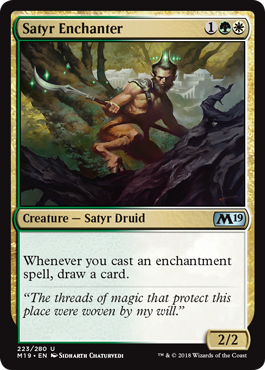
The story of Satyr Enchanter starts in Limited Edition (Alpha) with this card:
I believe Verduran Enchantress was a top-down enchantress. Enchantments tended to represent magic spells with permanence, so Richard Garfield liked the idea of a small creature that encouraged building a deck around enchantments. Verduran Enchantress was originally printed as creature type Enchantress, but that would go away later during when it became a Wizard and ultimately a Human Druid. Three years later, in the set Visions, we made the next Enchantress:
Femeref Enchantress tried a different take on an enchantress, caring about enchantments going to the graveyard from the battlefield. As global enchantments are harder to kill, this card pushed players more to take advantage of either Auras or enchantments that could sacrifice themselves. The fact that enchantments leaving the battlefield was harder to care about than entering the battlefield plus the fact that the card was multicolored (green and white were chosen because those were the two colors most connected mechanically with enchantments) allowed the card to be larger (1/2 instead of 0/2) for less mana. The next attempt at an enchantress was nearly two years later in Urza's Saga:
Argothian Enchantress was basically a better version of Verduran Enchantress with a lower cost and shroud, making it harder to kill with spells. It was a 0/1 instead of a 0/2, but as it never attacked or blocked and couldn't be targeted, 1 toughness wasn't the biggest of drawbacks. The next iteration, in Onslaught, tried something a little different:
Instead of a creature, Enchantress's Presence was itself an enchantment. This made it slightly harder to kill and, more importantly, allowed future copies to trigger and draw you cards. This was followed many years later by a card in Planar Chaos:
Planar Chaos was a set about exploring an alternate way the color pie could have been distributed (keeping the color philosophies the same). It had timeshifted cards that were all existing Magic cards colorshifted to different colors. Mesa Enchantress is Verduran Enchantress from Alpha, but shifted from green to white. This card later showed up in two different core sets, a Masters set and a Commander set (Commander is always looking for more card drawing for white). The most recent enchantress before Core Set 2019, from Journey into Nyx, wasn't even an Enchantress:
Eidolon of Blossoms had the constellation mechanic, which triggers whenever an enchantment enters the battlefield under your control. It was the one constellation card that drew you cards. As it was an enchantment creature, it allowed you to draw cards when you played future copies.
Which brings us to Satyr Enchanter. It's a Druid like the others, but as this card is creatively making a throw to Theros, the Enchanter is a Satyr. The card was also made green-white, allowing it to get a better mana cost-to-power/toughness ratio. It's also the first green-white Enchanter(ress) that draws a card when the enchantment enters the battlefield.
So, what does this mean for the future of this ability? I think it's going to remain base green, as we're trying to be careful with the kind of card drawing we give white and enchantments aren't quite narrow enough to justify giving a white card drawing by itself, but I could see more green-white Enchantresses in the future.
Tezzeret, Artifice Master
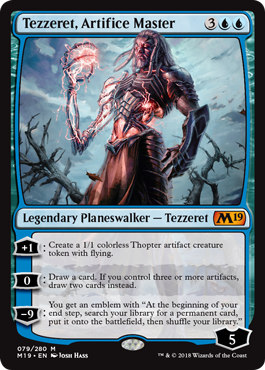
Tezzeret comes to Core Set 2019 from the Kaladesh storyline, so we made a card that captures that moment in time for him. While we don't know all the details, Tezzeret's appearance on Kaladesh was directly tied to his relationship with Bolas. Tezzeret's shtick is artifacts. He's another one of the Planeswalkers with the narrower mechanical focus.
His first ability makes a 1/1 flying Thopter creature token because we want to mechanically communicate that this is from the Kaladesh storyline. The lack of flavor text on planeswalkers can make it hard when we're doing something like Core Set 2019 where each planeswalker comes from a different time period. Creature tokens often serve as a good way to place a card because there are many creature tokens associated with particular planes, Thopters being a great example.
His second ability taps into a core blue ability, card drawing, but it ties it to artifacts to make it feel more Tezzeret-y. His third ability is a bit strange for Tezzeret as it's broader than normal. Most Tezzeret cards that get something out of your library get an artifact. The reason this card is a little more general, permanents rather than artifacts, is because we're trying to mechanically convey that Tezzeret is now in control of the planar bridge, an important story point at the end of the Kaladesh story.
Vivien Reid
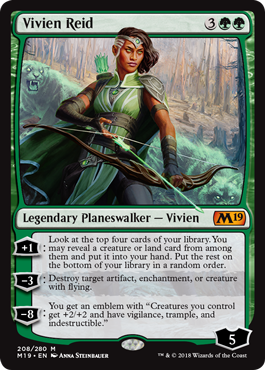
Finally, we get to our last and only new Planeswalker, Vivien. Vivien also represents a moment from the past, one where she interacted with Bolas, but that isn't a public story yet. Vivien came about because we realized that we were a little shy on monogreen Planeswalkers. Garruk got cursed in his fight with Liliana and became black-green. That left only Nissa as a monogreen representative (and even she's dabbled with a second color). Vivien came about because we wanted a new monogreen Planeswalker. The Creative team came up with a cool look, power suite, and backstory. To understand the card design, I can tell you she's an archer whose magical arrows can create creatures.
Vivien's first ability represents her tie to nature and animals. She allows you to search out a creature or land. Her second ability plays into her destructive nature and the idea that her bow and arrows can destroy things as well as create them. We let her have a choice between Naturalize and Plummet, as each of those is a niche answer and we wanted Vivien's second ability to be applicable in many games. Her ultimate plays into her tie to animals. This helps you turn your army of creatures into a potent force to help you win the game.
Vivien's Invocation
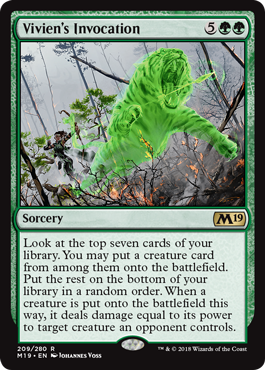
This spell does a slightly better job of showing off Vivien's power suite (it's hard for planeswalkers who serve as a portrait of the person to do this—well, unless their power is as easy to showcase in a portrait as Chandra's). Vivien's magical arrows turn into spirit versions of creatures from her home plane. In this art, we see Vivien's arrow becoming a huge tiger. The mechanical representation of this ability is you going and getting a creature off the top seven cards of your deck and putting it on the battlefield to "attack" a creature of your choice.
The other big question is this is sort of a direct-damage anti-creature spell in green, which green doesn't really do. The reason this is allowable is that it requires a strong concentration of creatures in your deck to make it work (having just one large creature isn't viable, because you only get to pick from the top seven; you need a higher creature density). This does represent us trying to find more ways to give green creatures control in a way that stays true to green's identity of being reliant on creatures.
Time to Put the Cards Away
And that is all the time I have for today. I hope you enjoyed my look through Core Set 2019. As always, I'm eager to hear your feedback on this article, any of the cards I talked about, or Core Set 2019 in general. You can email me or contact me through any of my social media accounts (Twitter, Tumblr, Google+, and Instagram).
Join me next week as I explore a new game design concept I've been thinking about.
Until then, may Core Set 2019 create many of your own stories.
#549: Parts of a Card
#549: Parts of a Card
I go through a Magic card and talk about what impact design has on each part of the card.
#550: Magic Evolution, Part 4
#550: Magic Evolution, Part 4
40:48
This is the fourth in my "Magic Evolution" series where I go through every Magic set and talk about the design innovations of each one. On today's podcast, I talk about the Odyssey and Onslaught blocks.
- Episode 548 Kicker
- Episode 547 Jumping-Off Points
- Episode 546 World Identities

